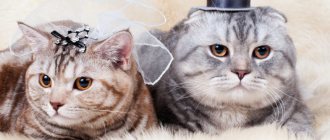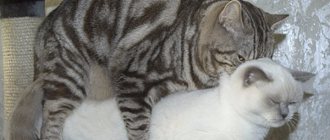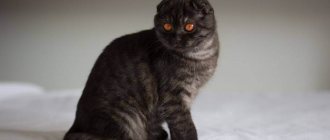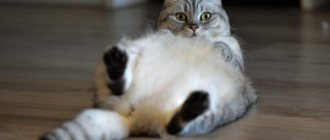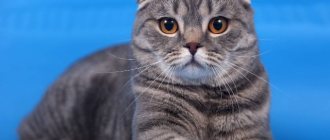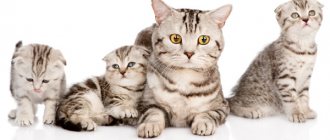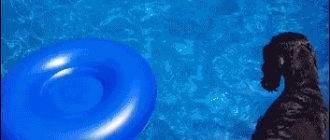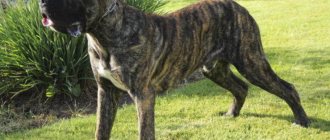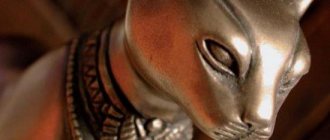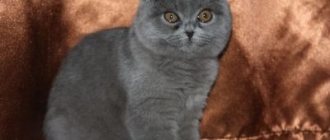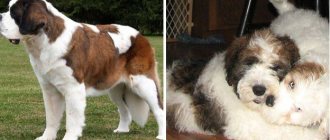Scottish cats have different colors. Scottish cats are famous because of their charming appearance and variety of colors. The color of kittens directly depends on certain genes. As a rule, these are two main shades, black and white.
Scottish Straight colors, for example, are gray with black stripes around the entire body. They are distributed as a percentage. That is, the animal’s fur is painted in two colors in different proportions. Its own gene is responsible for the dominance of one color or another.
Plain (solid)
The color of Scottish Fold cats is monochromatic and they should not have any other color. The fold-eared cat can be of the following colors: white and black, chocolate and lilac, blue and red, cream, fawn and cinnamon. The most popular color in the world among solid Scottish cats is blue. These are the majority of cats.
White
The white Scottish Straight cat can have different eyes, from blue and bright orange to rich amber and copper. Kittens of this variety remain white for the rest of their lives. If kittens have spots, then an adult cat remains white for the rest of its life.
Black
The Scottish Fold black cat is mostly bright in color. A couple of white hairs are acceptable, but if the cat has large red and brown patches, then it is not a purebred.
Black Scottish Fold cats should be bright black in color and their ears, like all fold-eared cats, should be pressed to the head, unlike straight-eared cats. A straight-eared black cat always has its ears erect.
Chocolate
The chocolate Scottish Fold looks impressive. The chocolate color is quite rare. Brown fold kittens should have a smooth, uniform coat of chocolate color. The dark brown coloring adds nobility to the cat.
A brown cat gets this color if he has chocolate, chocolate bicolor or chocolate color points in his pedigree. Chocolate Scottish kittens always delight their owners. They look very cool against a light background.
Lilac (lavender)
A lilac long-eared cat gets this color if he has either lilac color points or lilac in his pedigree. The lilac coloration goes well with orange, copper or amber colored eyes and a light brown nose. This color is also called coffee with milk.
Blue color (blue)
The Scots Blue can have a coat color of many shades of blue. Some cats may have a fur color closer to gray, and some closer to blue. Each hair must be saturated, then the coat will be perfectly blue.
A bit of genetics
Many people are interested in learning how the colors of Scottish cats are formed. In Scottish cats, two genes predominate, responsible for black and red coat colors. Each of them can act as a dominant (suppressing weaker genes) and recessive (suppressed gene). And there is a third diluent gene, responsible for the saturation of the pigment. Combining in a certain order, these genes can give completely unimaginable coloring.
The presence of one color or another in a Scottish kitten cannot always be determined in the first weeks of life. This is not the final shade yet, because the coloring becomes brighter and more pronounced only when the coat is replaced by an adult during the baby's molt. This happens around six months of age. But up to 2 years, the shade may still change slightly.
Bicolors
The coat color of these beautiful creatures has two colors, and a combination of white and any other shade is mandatory. Purebred bicolors must have a white belly, neck, chest, chin, limbs and, of course, muzzle.
Particolor (calico)
A Scottish cat of this type, called particolor, is a combination of white with tortoiseshell or spotted tabby color.
Harlequin
Harlequin captivated everyone with his unusual appearance. The cat is painted white (4/5 parts of the body), but the tail must be black, as well as the ears and the top of the head. The ventral part is white. The tip of the nose, like most people, is the same color – pink.
Wang
This breed only has colored tail, and sometimes has a few spots on the head. It happens that there are solid spots on the paws and back, but this is considered undesirable. When this breed develops red spots, it may also be called a Red Van.
Reviews from owners of Scottish Straight cats
“Although the Scots are often described as super-domestic cats, our Mason is a true hunter. In the apartment he manages to catch flies, and he grabs the toy the first time, without much teasing. Exceptional cat! He has his own opinion on everything. I love talking to him – he always mumbles something in response.”
“What I like most is that our Scottish Straight does not single out any one person from the family. She loves both me and her husband equally. And sits in both of their arms, and approaches everyone to ask for food. He tolerates loneliness well, which is also important - we both work a lot. We leave him a bunch of toys as compensation. It is not given to guests at all, although it has never scratched anyone. My husband is secretly pleased with this, he considers the cat a loyal and correct boy.”
“Our Busilda was transformed gradually. When they brought me this skinny worm on legs for my birthday, I didn’t believe that it was a purebred Scot. I got it, I think, on Avito, for three rubles. But a kitten is like a child, you will love anyone. At 5 months the coat began to bloom and change color. And by the age of one year, Busya had become a cheeky, plush, stately beauty! We castrated her early, at 6 months, but there is no excess weight, just nice roundness.”
“I adopted a Highland Straight after I couldn’t persuade my family to adopt a Persian cat. I have never regretted it! Simon is absolutely devoid of aggression, goes to the litter box without a single mistake, and always sleeps with me. He purrs a lot, my little babbler. I comb it twice a week to prevent tangles from forming. It’s not difficult, but the cat is amazingly beautiful! Grew up to 5 kg, large, but in moderation"
“Highland Straight became the second Scot in our family. Without hiding I say that the kitten was taken for children. Blue with yellow eyes, incredibly fluffy - tail like a fan, fur pants, collar. Very affectionate and patient, a full member of the family."
Color point
The Color Point is a rare breed of Scottish cat with a color similar to that of a Siamese cat. In childhood they look a little like Thai kittens. The main background is white or cream. The muzzle, ears, paws and tail are painted in darker shades. Color point or links point have blue eyes.
They acquired their colors from their British ancestors, who had Persians with this shade in their family. By the way, it is very difficult to distinguish a British cat from a Scottish one, and even professionals cannot always do this.
Nutrition
When choosing food, do not skimp and choose products of at least super-premium class, this way you will protect your pet from stomach diseases.
If you feed your cat natural products, you will have to fork out for fish, lean meat, cheese and various dairy products. It will only be whites.
The animal can get carbohydrates from bread, various cereals and potatoes, and fats from egg yolks and vegetable oil. With such feeding, it is necessary to add vitamin-mineral complexes to the food.
Tabby (tabby)
Tabby is one of the most popular cats among Scots. The color of Scottish tabby cats is distinguished by the presence of a pattern in a certain area on the coat. The pattern on the wool can be anything. A distinctive feature is considered to be a pattern in the form of the letter M on the forehead.
Tabby color depending on the type of pattern:
- striped like a tiger (has vertical stripes on the sides);
- spotted;
- marble (pattern of chaotic spots and stripes of different sizes).
And depending on the color combinations to the following:
- golden tabbies;
- cream tabby;
- blue;
- black marble;
- marble on silver
- silvery blue (gray tint);
- silver (silver color);
- cameo.
RARE COLORS
Ticked
An extremely rare Scottishfold color. These kittens are very expensive. The peculiarity is the coloring of the fur hairs. Sometimes it is called "Abyssinian". Each hair must have at least three dark stripes. It looks like small specks on the fur. Stripes on the paws and on the tip of the tail are allowed. The letter "M" and a necklace of stripes around the neck. This color is also called “pattern without pattern.” Yellow, dark orange, orange eye color, for silver ones – green.
Chinchilla
Rarely seen, elegant color. Only 1/8 of the tips of the fur are dark colored. Currently, silver, gold and blue-gold colors are known.
All Scottishfold colors are beautiful, sophisticated and amazing in variety. These cats are funny and cute, surprising with their habits. Therefore, the Scottish breed is loved all over the world. And no matter what kitten you choose, it will bring you many pleasant moments in its company.
Matching eye color to coat color
Until four months it is impossible to determine eye color. It can be identified by its fur, the shade of which may change. There is a special table by which you can determine the eyes of an animal. It must be remembered that the final result cannot be guaranteed, but in the vast majority of cases it coincides with the data in the table.
Table of correspondence between eye color and coat color of Scottish cats.
Character
By nature, this is not a conflict animal. Ideally gets along with small children or other pets. Due to its dislike of conflicts, the cat would prefer to calmly leave rather than start defending itself and extending its claws.
The cat does not like to be picked up against his will. He will not fulfill your requests without desire.
It is easy to train, so there will be no problems with potty training. Parenting is also easy - the baby quickly understands what not to do.
He won't suffer much from loneliness if you have to leave for work until the evening. At the same time, he is quite loving - he loves affection and stroking from the owner.
But if you are busy, then the cat will not insist on playing and make noise for no reason. He can wait.
- Where can I take veterinary courses and what are they for?
- Akita Inu. What kind of breed is this and what are its characteristics?
Siamese cat - description of the breed, character and features of caring for Siamese cats (105 photos and videos)
Photos of Scottish Straights
Read here Napoleon cat breed - history of breeding, description of the dwarf breed and a detailed overview of cat care (105 photos and videos)
Help the site, share with friends 
Selection rules
Scottish Straight kittens can only appear as a result of crossing Scottish Straight and Scottish Fold individuals.
Unscrupulous breeders may not cull kittens in order to earn more money.
Keep in poor conditions or feed with cheap food. All these factors can affect the health of the animal. And bringing a pet home, instead of joy, it can bring sadness and treatment costs.
Therefore, it is worth knowing what to look for when choosing a kitten:
- Activity. The baby should be active, playful and cheerful. If he huddles in a corner, it is important to recognize whether he is cowardly or whether he is simply sick.
- Appetite. Everything is clear here - eating well means being healthy.
- The ears and under the tail are clean.
- Eyes. Eye discharge is normal for this breed until it turns color. Therefore, remember - if the eyes are watery, this is a feature of the breed, and if they turn sour or discharge of any color appears, this is a sign of illness or inflammation.
- The tummy is soft.
- Each cub in the nursery must have a veterinary passport with all vaccinations and anthelmintic procedures.
- Pedigree, if any.
IMPORTANT! The purchase of a kitten must be made under a sales contract.
Breed variety
There are four varieties of Scottish kittens known all over the world:
- Scottish Folds, shorthaired folds are cute Scottish kittens. With velvety soft fur, a wonderful muzzle, with round big eyes and unusual ears curled inward
- Scottish Straight, short-haired straight. They differ from folds only in their sharp, protruding ears. With soft, densely stuffed fur and a large head, it looks like a small bear cub with its ears peeking out.
- Highland Fold, a semi-long-haired, fold-eared, fluffier kitten, with a round head covered with hair, in which folded ears are hidden. Its appearance resembles an extraterrestrial creature.
- The Highland Straight, a semi-long-haired straight-eared breed, differs from other species in having longer hair and the corners of its ears peeking out from under the fur on its round head.
Fold
In a well-known professional nursery with a good reputation, a purebred Scottish Fold kitten from purebred producers will be expensive. Price depends:
- depending on the class, the show is much more expensive than pet, breed;
- depending on the color, how popular it is;
- A fold-eared kitten is always more expensive than a straight-eared one;
- cats are more valuable than cats;
- From where the nursery is promoted, kittens in Moscow and St. Petersburg are more expensive than in the regions;
- On holidays, kittens are sold as gifts to loved ones, and the price increases sharply.
In general, the average price for a Scottish fold kitten ranges from 10 thousand to 30 thousand rubles .
Straight-eared
Straight-eared Scottish kittens, Scottish straights, are a little cheaper, the price depends on the class, coat color and the availability of documents. On average they cost from 20 thousand. rubles up to 8 thousand rubles.
Kittens of rare colors can cost from 25-40000 rubles and above :
Shorthair
Shorthaired Scottish Straight and Scottish Fold kittens with documents can cost:
- pet class can cost from 5 thousand rubles ;
- breed class can cost from 10 thousand rubles ;
- show class can cost from 15 thousand rubles to 30 thousand rubles ;
- rare colors can cost from 25 thousand rubles to 40 thousand rubles .
Longhair
Longhaired Highland Straight and Highland Fold with documents can cost:
- pet class can cost from 5 thousand rubles ;
- Breed class can cost from 8 thousand rubles ;
- show class can cost from 10 thousand rubles to 20 thousand rubles ;
- rare colors can cost from 25 thousand rubles to 40 thousand rubles .
